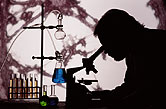
TUESDAY, Aug. 13 (HealthDay News) — A protein that accumulates in healthy aging brains could prove to be the culprit behind the natural forgetfulness that comes with growing old as well as advanced neurodegenerative diseases such as Alzheimer’s, according to a new study.
The protein, known as C1q, accumulates on the brain’s synapses as people age, potentially gumming up the works, said Dr. Ben Barres, professor and chair of neurobiology at the Stanford University School of Medicine and senior author of the study, published Aug. 14 in the Journal of Neuroscience.
A post-mortem review of mouse and human brains found that the amount of C1q in the brain increases as much as 300-fold with aging.
By comparing brain tissue from mice of varying ages as well as postmortem samples from a 2-month-old infant and an older person, the researchers found that the growing C1q deposits weren’t randomly distributed along nerve cells.
Instead, they heavily concentrate at synapses (the junctions between nerve cells), where they could hamper the conduction of electrical and chemical signals in the brain.
“Synapses are not being lost,” Barres said. “However, we see the synapses aren’t working so good with all that C1q stuck to them. It’s detrimental.”
But C1q is known to play an important part in the developing brain during childhood, and Barres suspects that this function could lead the protein to attack the synapses if triggered. Such an attack could be the cause of Alzheimer’s disease and other neurodegenerative disorders.
This hypothesis runs counter to prevailing theories about Alzheimer’s, which have focused on the accumulation of amyloid plaques in the brain as a cause of the disease.
In a normal developing brain, synapses are both created and destroyed — a process Barres likens to “pruning” the brain by preserving necessary synapses and eliminating the excess.
“What wasn’t clear is what the molecular basis of the synapse pruning was,” Barres said. “It involves a normal immune protein that people didn’t even realize was in the brain — C1q.”
C1q is capable of clinging to the surface of foreign bodies such as bacteria or to bits of dead or dying human cells. This initiates a molecular chain reaction known as the complement cascade. One by one, the system’s other proteins glom on, coating the offending cell or piece of debris. This in turn draws the attention of omnivorous immune cells that gobble up the target.
Barres now hypothesizes that diseases such as Alzheimer’s might develop if the C1q that has accumulated on the synapses triggers an immune system attack against them.
“The first regions of the brain to show a dramatic increase in C1q are places like the hippocampus and substantia nigra, the precise brain regions most vulnerable to neurodegenerative diseases like Alzheimer’s and Parkinson’s disease, respectively,” Barres said. Another region affected early on, the piriform cortex, is associated with the sense of smell, whose loss often heralds the onset of neurodegenerative disease.
“Our findings may well explain the long-mysterious vulnerability specifically of the aging brain to neurodegenerative disease,” he said. “Kids don’t get Alzheimer’s or Parkinson’s,” Barres pointed out.
“Profound activation of the complement cascade, associated with massive synapse loss, is the cardinal feature of Alzheimer’s disease and many other neurodegenerative disorders. People have thought this was because synapse loss triggers inflammation. But our findings here suggest that activation of the complement cascade is driving synapse loss, not the other way around,” Barres explained.
Heather Snyder, director of medical and scientific operations for the Alzheimer’s Association, said the new study “adds to the body of information that looks at how the immune system might work in Alzheimer’s disease.” She added that there are many hypotheses that need to be explored about what may be happening in Alzheimer’s.
Noting that much of the research in the current study involved mice, Snyder said future studies need to focus on how C1q affects human brains.
“This is really opening the door that this should be explored further,” she said. “It needs to be replicated in the laboratory and also correlated to what it may mean in human beings.”
More than 5 million Americans have Alzheimer’s disease, and that number is expected to rise significantly as the baby boom generation ages.
More information
For more information on Alzheimer’s disease, visit the U.S. National Institute on Aging.
Copyright © 2025 HealthDay. All rights reserved.

